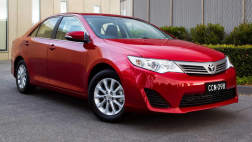Mount Isa is not a place you would go hunting for James Bond.
His car? Now, that's a different story.
As development of the all-new Aston Martin DB11 accelerates towards showrooms, including the first public appearance of the car at the Geneva motor show this week, Mount Isa takes on a new importance for the British sports car company.
The giant mining town is precisely the place chosen by a team of engineers who are doing final calibration work on a heavily-camouflaged test car. They want hot weather, high speeds and the minimum number of prying eyes.
So, then, what am I doing with Aston in the Isa?
The new M at Aston, a razor-sharp and old-school British gentleman called Simon Sproule, has called me with an assignment. He wants me to ride along with the engineers, take an inside look at the DB11, and see how I feel about the car that's finally bringing the brand into the 21st century.
Like all the best Bond stories, things do not run to plan
How can I refuse?
The DB11 is completely new from the road up, plugs into Mercedes-Benz technology for the first time, has some lovely trickery including an air inlet behind the side windows that's plumbed to a pop-up spoiler, and arrives with the promise of a digital dashboard that I will finally be able to read in the harsh Australian sunshine.
But, like all the best Bond stories, things do not run to plan.
The weather is not being kind with rain and relatively cool weather. There are inevitable technical glitches. And lots of people are taking pictures of the DB11 after its 'outing' in Melbourne while it was being readied at Ford's You Yangs proving group for the long anti-clockwise run up through Adelaide and Alice Springs to the Isa, then across to Townsville and back down the east coast.
"We haven't even seen any kangaroos," laughs Nadeem Arshad, the engineer in charge of the test run.
He's an air-conditioning expert and is doing all the driving in the left-hand drive test car. It's not a prototype, because it was built on the regular Aston Martin production line, but it will eventually be scrapped after its hot-weather trial in Australia and a similar verification run to the snowfields in the north of Finland.
I'm introduced to Arshad and his small crew, as well as the hard-working DB11, in a private corner of a hotel parking lot. The car is dirty and a bit shabby, but it's obvious that a massive amount of work has gone into every part of it, even including all-new boot hinges - which previously looked like something from the 17th century - and a huge re-work of the V12 engine.
It's the car Aston has to have, as well as the start of a complete overhaul of the company's product lineup that will even include its first SUV.
Aston is teasing me with some early technical details on the car, which reveal it's a conventional 2+2 grand tourer with an all-new aluminium structure, the heavily re-worked 5.2-litre twin-turbo V12 with an eight-speed automatic gearbox, rear-wheel drive, 20-inch alloys and some neat stuff including LED headlamps.
Not that I'm really going to notice.
It's a signal of where Aston Martin is going
I'm banned from the driver's seat and, even though the car has 447 kiloWatts and 700 Newton-metres of torque, more than enough for a 0-100km/h sprint in 3.9 seconds and a top speed of 322km/h, Arshad has no intention of proving it.
"The only carryover is the door handle. It's effectively a clean sheet of paper," says Dave Adams, the Aston PR chief and DB11 bodyguard for the trip.
"It replaces the DB9. It's the core GT car for the entire second-century range. And it's a signal of where Aston Martin is going."
As I slide into the passenger seat I'm welcomed by gorgeous old-school leather bucket seats and a dashboard which finally belongs in the here-and-now. The dials are big and easy to read, there is a tablet-style infotainment display that's big and easy to use, and the view out over the bonnet is promising an open-road fun run.
But, what's this? A Mercedes-Benz key, where Aston previously used its unique sapphire crystal 'Emotional Control Unit' to start the car.
Aston says it's only a temporary solution to ensure the Mercedes electrical system plugged into the car will function for the test. And it is definitely not a sign that Mercedes-AMG is driving the program.
"It's just to get the car running at the moment," says Adams.
"It's an Aston Martin with a bit of Mercedes-Benz blood. We choose the bits we want, with what works for us. They don't force anything on us."
With that, we're off.
I still have far more questions than answers
The car is quieter than I expect, a good deal smoother, and the suspension absorbs bumps instead of sending them directly into the passengers. There seems to be more room inside, definitely in the back, and the aircon - as predicted - is brilliant.
The car is running with 255x40 front tyres and 295x35 Bridgestones on the back, but there is far less road noise than any Aston I have been in before the DB11. Even the exhaust note is subdued in the standard setting.
It looks and it feels like a more-complete package, and a car that is not rooted in the thinking or engineering of the past. If I was asked for a guess, I'd say development of the DB11 has cost more than $1 billion.
My ride-along run is over far too soon, but I'm not disappointed. It's bad enough to be in a car this quick on bumpy secondary roads with a 100km/h speed limit, without being nailed into the passenger seat.
I've seen a lot and learned a little, but I still have far more questions than answers.
Now I'm looking forward to a proper first drive, seeing what it car really do, and enjoying a bit of 007-style action in the DB11.




.jpg)
.jpg)






.jpg)
.jpg)
.jpg)









_0.jpg)


.jpg)

Comments